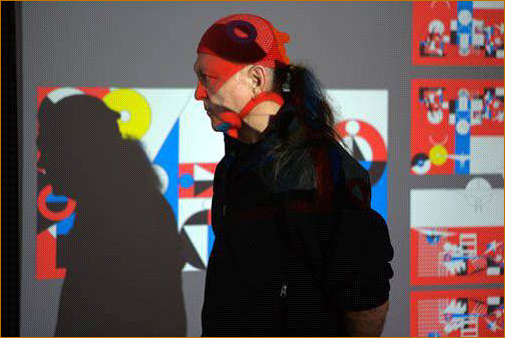|

Sections on this page:
 Introduction
Introduction
BARGELLO
NATIONAL MUSEUM
VIA DEL PROCONSOLO 4
FLORENCE, ITALY
9 JULY – 11 OCTOBER, 2015
MUSEUM HOURS: 8:15am – 5:00pm
TheAscentOfOrpheus.org
DaPlastique.com
The Ascent of Orpheus. For the first time in its 150-year
history, the Bargello National Museum hosts a solo contemporary
art show, THE ASCENT OF ORPHEUS: Between and Beyond Representation
and Abstraction, by the American-born artist Adi Da Samraj.
In an unusual bridging of ancient myth and digitally composed
large-scale fabrications, the exhibition is Adi Da’s sweeping
and at times demanding retelling of the famous Orpheus and
Eurydice myth. The exhibit runs from 9 July to 11 October
2015 in two galleries off the Bargello courtyard.
Through the nine large-scale pieces and the multimedia projection
in the exhibition, Adi Da demonstrates his radical approach
to “aperspectival, aniconic, and anegoic” art. Drawn from
his Orpheus One and Linead One suites created
in 2007, the digitally composed works, some never shown publicly
before, demonstrate the artist’s reach beyond the linear perspective
and individual “point of view” that have dominated Western
art since the Renaissance. The exhibition is also a testament
to Adi Da’s advance in what he considered to be the unfinished
modernist project of the early 20th-century avant-garde.
Achille Bonito Oliva, the internationally acclaimed Italian
art critic and historian who curated Adi Da Samraj’s official
collateral exhibition at the 2007 Venice Biennale, notes in
his essay in The Ascent of Orpheus exhibition catalog:
“The abstraction of Adi Da Samraj is anti-rhetorical and aspires
to restore humanity to a state of contemplation and reflection
. . . His abstract images look upon the world from beyond
any point of view.”
Divina.com: July 9, 10, 11 — The exhibition
coincides with the 750th anniversary of the birth of Dante
and opens with collaborative performances of Divina.com
by the Florence Dance Company on 9, 10, and 11 July in the
Bargello Museum courtyard. The ballet, inspired by Dante’s
Divine Comedy, integrates monumental projections of
images by Adi Da from Linead One. The images move on
screen in dynamic interaction with the dancers and are also
the inspiration for the costume design. The ballet is accompanied
by live musical performances from pianists Stefano Maurizi
and Naamleela
Free Jones and avant-garde electronic rock by Maurizio
Fasolo and the group Pankow.
Tickets are now available for all three performances:
- July
9 (Inaugural Event) — The Inaugural Event
includes entertainment by Fidget Feet, a ribbon cutting
ceremony, Exhibition viewing, cocktails, the opening ceremony
for the Florence Dance Festival, and the performance of
Divina.com.
- July
10
- July
11
Finissage: October 8 — You are invited to a
finissage celebrating the conclusion of The Ascent of Orpheus
exhibition, at 6:00pm on Thursday, October 8, 2015. Noted
art critic, Giuliano
Serafini, will give an illustrated presentation on the
art of Adi Da. Also, the Florence Dance Company will give
a special, multimedia performance, Orpheus Ascending,
accompanied by a multimedia presentation (projected behind
the dancers) of the art of Adi Da Samraj. The evening will
conclude with cocktails.
Exhibition Catalogue. A 112-page catalogue entitled
The Ascent of Orpheus: Between and Beyond Representation
and Abstraction accompanies the exhibition. Offering a
visually rich survey of Adi Da’s Orpheus One and Linead
One suites, the catalogue includes images from the exhibition,
numerous additional images from the two suites, as well as
commentarial essays on the suites and selections from Adi
Da’s own writings on art.
DaPlastique and the Adi Da Foundation. Da
Plastique is a division of the Adi Da Foundation and is
responsible for the worldwide dissemination and promotion
of the art of Adi Da Samraj. The Adi Da Foundation is charged
with bringing the legacy of Adi Da Samraj — his visual and
literary art, message about world peace, and philosophical
and spiritual teachings — to audiences around the world.
 About The Artist
About The Artist 
Adi Da Samraj (1939–2008) created visual, literary, and performance
art for more than forty years with a single intention: to
create works of art that would draw the viewer beyond the
feeling of egoic separateness into the feeling of “prior unity.”
His artistic output includes drawings, paintings, sculptures,
and a large bodyof groundbreaking photographic, videographic,
and digitally composed work. Adi Da’s work appeared as anofficial
solo collateral exhibition at the 2007 Venice Biennale, in
a solo show in the historic Cenacolo di Ognissanti (Florence),
and in gallery and art shows in New York, Los Angeles, Miami,
London, and Amsterdam.
Peter Weibel, Chairman of ZKM Center for Art and Media (Karlsruhe),
notes that “[Adi Da’s] pursuit of the spiritual paths found
in early abstraction, from Kandinsky to Mondrian, and [his]
translation of that pursuit into the digital age, restore
a transcendental spirituality to the materialism of the machine
aesthetic.” Art critic Donald Kuspit has written, “Protean
and unified at once, Adi Da’s ever-changing images become
all-pervasive ‘big screen’ experiences, perceptually riveting,
indeed, sometimes excruciatingly intense, but always balanced
and even sublime sensory experiences.”
In addition to being a prolific artist, Adi Da Samraj is
a widely recognized spiritual teacher who produced many volumes
of literary, poetic, practical, philosophical, and spiritual
writings.
 Adi Da's Orpheus and Linead Suites
Adi Da's Orpheus and Linead Suites

Solo Exhibition: "The Ascent of Orpheus".
The exhibition of Adi Da's "The Ascent of Orpheus"
will be held in two galleries on the courtyard level of the
Bargello National Museum. Seven monumental fabrications from
Adi Da's Orpheus One and Linead One Suites will
be featured in Gallery #1. Gallery #2 will feature the premiere
of a newly commissioned Orpheus One fabrication:
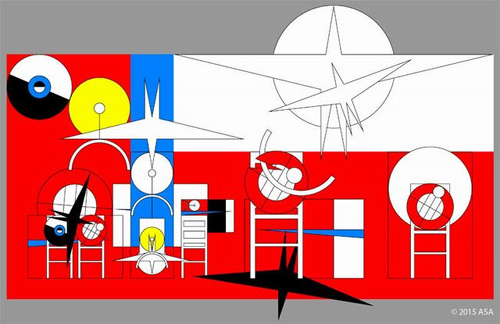
The Spiritual Descent of The Bicycle
Becomes
The Second-Birth of Flight Part Six, VII, from Orpheus One
2007, 2014 – Lacquer on aluminum, 77 x 119 inches / 196
x 302 cm
© 2015 ASA
[Click
on image for enlargement]
Adi Da’s digital drawings are informed by a
complex vocabulary of forms, colors, and spiritual concepts.
In His suites, Orpheus One and Linead One, He
uses two major visual elements in each work, which He calls
lineads and geomes. Lineads are hand-drawn gestural marks
and curvilinear lines; geomes are solid geometric shapes.
There is a momentum that takes place as the lineads uncoil
upon the harmoniously positioned blocks of colors or the geomes.
Together these forms unite to create a sense of dynamism and
movement within the drawings.
|
The secret of Orpheus is hidden (or encoded) in the
images — the secret of the flight out of the hell and
into the Earth-world, and, ultimately, into the Divine
Domain of Conscious Light.
Avatar Adi Da Samraj
|
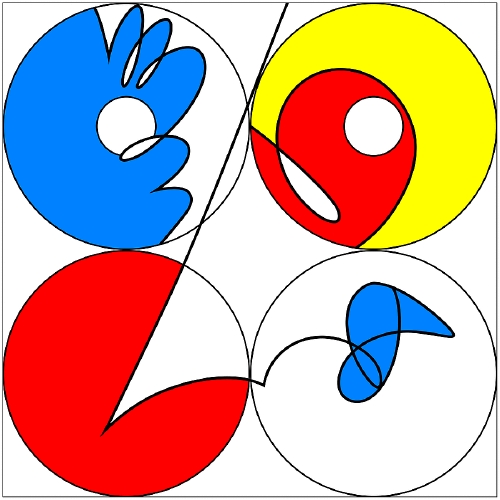
Eurydice One: The Illusory Fall of The Bicycle Into
The Sub-Atomic Parallel Worlds of Primary Color and
Point of View - Part Three: The Abstract Narrative
In Geome and Linead (Second Stage) - 1, 2
2007, 2010 Lacquer on aluminum 96 x 96"
© 2011 ASA
[Click on image for enlargement]
|
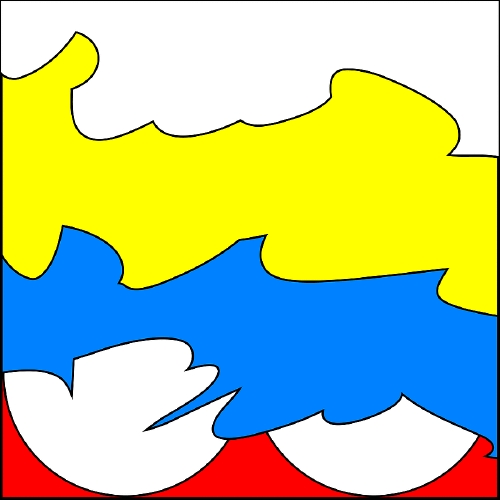
Eurydice One: The Illusory Fall of The Bicycle
Into The Sub-Atomic Parallel Worlds of Primary Color
and Point of View - Part Three: The Abstract Narrative
in Geome and Linead (Second Stage) - V, 2
2007, 2010 Lacquer on aluminum 72 x 72"
© 2011 ASA
[Click on image for enlargement]
|
Related links:
- Images from Orpheus and Linead were first exhibited
at the Sundaram Tagore
Gallery in New York, in September, 2009.
- Opening
Night remarks by Achille Bonita Oliva, at the September
2009 exhibition of Adi Da's Orpheus and Linead (video).
- A further showing of images from Orpheus and Linead
was exhibited at the Sundaram
Tagore Gallery in Los Angeles, in September, 2011.
- Orpheus
in the Modern World, art panel held on October 5, 2011,
based on Adi Da's art in Orpheus and Linead (audio).
- For more about Orpheus and Linead, read and view
the exhibition catalog, Orpheus
and Eurydice.
 The Bargello National Museum
The Bargello National Museum
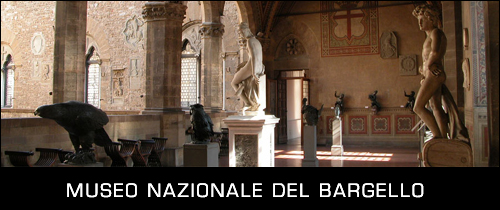
The Bargello
National Museum in Florence, Italy has its setting in
one of the oldest buildings in Florence, dating back to 1255.
The Bargello is world-renowned for its sculpture collections,
and, in particular, for hosting the world's largest concentration
of masterpieces by Donatello. 2015 is a special year: the
150th Anniversary of the Museum.
The Bargello Museum also houses masterpieces by Michelangelo,
such as his Bacchus, Pitti Tondo ("Madonna and
Child"), Brutus, and David-Apollo. Its collection
includes Donatello's David and St. George Tabernacle,
Vincenzo Gemito's Pescatore ("fisherboy"), Jacopo Sansovino's
Bacchus, Giambologna's Architecture and his
Mercury, and many works from the Della Robbia family.
Benvenuto Cellini is represented with his bronze bust of Cosimo
I. There are also a few works from the Baroque period, notably
Gianlorenzo Bernini's 1636-7 bust of Costanza Bonarelli. The
museum also has a fine collection of ceramics (maiolica),
textile, tapestries, ivory, silver, armours and old coins.
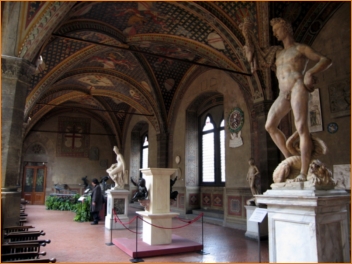
(click picture for enlargement)
Adi Da's image-art — the first solo contemporary art
show to be exhibited in the 150-year history of the Bargello
— combined with these centuries old masterpieces, will
create a stunning juxtaposition, like the one created in the
Cenacolo di Ognissanti in 2008:
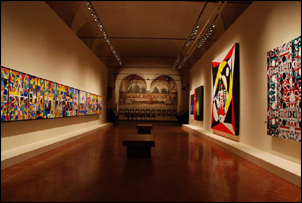
(click picture for enlargement)
 Divina.com by the Florence Dance
Company
Divina.com by the Florence Dance
Company 
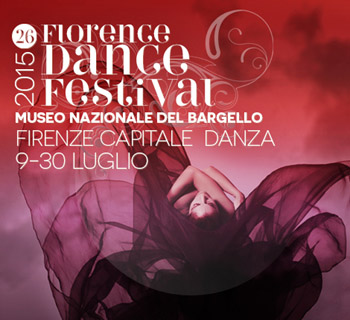
On July 9, 2015, The
Florence Dance Company will open the 26th
annual Florence Dance Festival with the 2015 version of
the multimedia ballet event,
Divina.com.
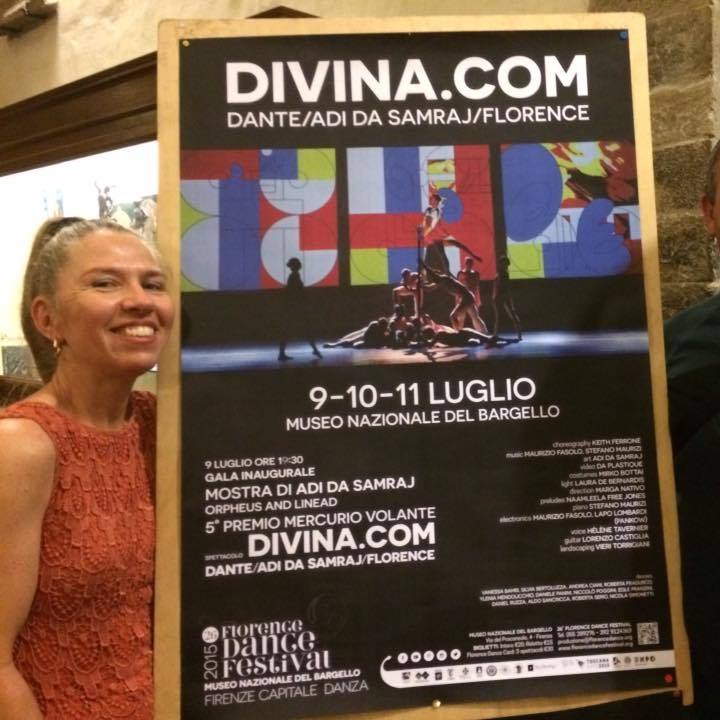
Divina.com is a comprehensive
aesthetic experience. Based on Dante's masterpiece, La
Divina Commedia (The Divine Comedy"), it is accompanied
by live musical performances from pianists Stefano Maurizi
and Naamleela
Free Jones and avant-garde electronic rock by Maurizio
Fasolo and the group Pankow.
Behind the dancers are large screen projections from Adi Da's
Linead One. The dancers' costumes are also inspired
by the Linead One
Suite.
| The 2015 performance also
commemorates the 750th anniversary of the birth of the
great poet, Dante Alighieri.
Divina.com joins the more than 200 cultural events
in Italy and around the world commemorating this occasion. |
 |
There will be three evening performances (July 9 – 11) at
the Bargello National Museum, timed to coincide with the first
three days of Adi Da's solo exhibition, The Ascent of Orpheus.
"Divina" means "to be Divine" and also
alludes to Dante's Divine Comedy.
".com" refers to the interconnectedness of the
Internet, which brings the world together in our time.
Divina.com has its roots in the great poem of Dante.
Like Dante's epic poem, Divina.com is a journey from the darkest
corners of human nature to its most illumined virtues, while
simultaneously inviting the voyager to discover that, in the
words of Adi Da, "Reality Itself is Truth Itself is the
Beautiful Itself" through unguarded particiption in His
Art.
Divina.com
has three, half-hour long parts: Inferno, Purgatorio,
and Paradiso, corresponding to the three parts of Dante's
epic poem. Keith Ferrone, the Choreographer and Director of
Divina.com (and the director of the Florence Dance Company)
elaborates. (We reprint his description from the
Florence Dance Company website.)
- Inferno interprets the universal
aspects of Dante’s story through movement, giving a sense
of human struggle and entrapment, of souls in anguish and
confusion, and a fruitless search for the Divine Light,
which is seen as a faint glimmer beyond our grasp.A tapestry
in motion weaves across the stage, in response to Dante’s
vision and to the art of Adi Da Samraj, creating a sense
of the great struggle to achieve divine order amidst the
apparently hellish maze of experience. Finally the stark
face of the "devil" appears as the root source
of our suffering, our "sin" or failure to meet
the mark of love under all conditions. Thus, as in the famous
portrait of Paolo and Francesca in Canto V of his Inferno,
Dante learns the great suffering of all sin, and is moved
to transcend it by moving onward toward his loved one.
Inferno Art: Adi Da's art selected for Inferno
represents in abstract terms Orpheus' descent into hell
to rescue his loved one Eurydice, and a visual exploration
of their entrapment there. Although the elements are highly
abstract, the parallel to Dante's journey into hell can
be intuitively felt. The abstract "linead" forms
(free-drawn line forms) seem to fall from left to right
across the panels, with the primary (fiery) colors of red
and yellow dominating over blue and white.
- Purgatorio finds us in between the extremes
of heaven and hell, where, having faced the lessons of the
inferno, Dante begins his ascent to the heavenly realm of
light and love above. There is a sense of waiting and penance,
of learning the path of light beyond the struggle of sinfulness,
but as yet the forms of experience only tend to continue
and repeat, never fully resolving in the present-time enjoyment
of the divine state of grace. The changed music and art
suggest a sense of streaming consciousness — normal
day life suspending in plastic time.
Purgatorio Art: Adi Da's artwork for Purgatorio
is full of abstract references to the struggle to ascend,
with a complex maze of ladders and planes, and chairs for
waiting, the sense of flight and hope portrayed in the free-line
forms that are caught uneasily between shifting angles and
rectilinear shapes. Here, blue and white have begun to dominate
the primary colors of red and yellow, but they are intertwined
in a complex field without resolution.
- Paradiso offers the final resolution of
Dante’s story, with the dance performed on point to represent
the glorious ascent into the heavenly realm of divine light
and love. There is a series of visual movements in response
to the nine spheres of Dante’s Paradiso. Here we see the
Divine house built according to the Divine order and geometry,
based on the strong foundations of universal unity and lovers
forever united and as one. There is a celebration of angelic
joy and ecstasy as Dante learns the model for living life
according to the highest ideals, which resolves ultimately
in the eternal life of Divine Radiance, where the perfumed
garden grows untarnished and eternally bright.
Paradiso Art: For Paradiso, two of Adi Da's
images were selected, a triptych and a diptych, which communicate
a sense of resolve of the heroic struggle of Orpheus to
ascend out of hell and a sense of epiphany and ecstasy in
the symmetry of the image elements. The final diptych communicates
the resolution of blue and white dominating over the red
and yellow flames of the inferno, with the final panel coming
to rest with the purity of the white central sphere radiating
amidst a pure blue field, a simple visual allegory to the
Divine Domain of Light above.
The July, 2010 performance
We will be posting pictures from the 2015 performance of
Divina.com here, as they arrive. But in the interim,
here are some pictures and descriptions from the inaugural
July, 2010 performance.
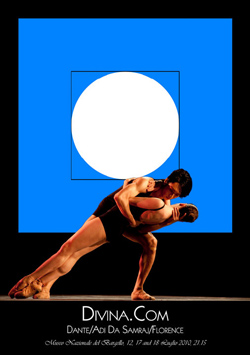
(click picture for enlargement)
|
The July, 2010 Divina.com ballet
was performed in front of a monumental screening of
Adi Da’s Art from the Linead – Eurydice suite
(an hour and a half long). The projection was done by
a state-of-the-art projection company on an enormous
screen that is 5 meters (16.25 feet) high by 12 meters
(39.6 feet) wide.
The music was composed by the professional
music group, Pankow. The renowned pianist, Stefano
Maurizi, accompanied Pankow. The music was partly
live, partly pre-recorded. Each of the 3 segments of
Divina.com had a prelude, composed and performed live
by Naamleela
Free Jones on the piano.
|
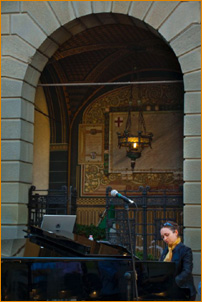 |
| |
(click picture
for enlargement)
|
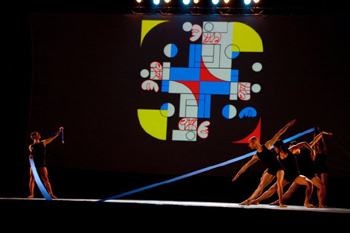
Divina.com: 'out of town' pre-opening
(click picture for enlargement)
French composer and singer, Hélène Tavernier
(of the electronica group, Angel Factory), composed music
to text from Dante and Adi Da Samraj, and sang her compositions
in Italian, French, and English.
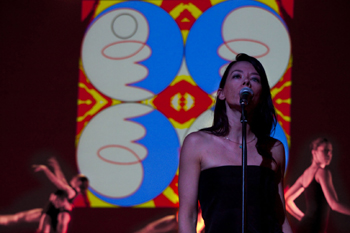
Hélène Tavernier singing: 'out of town' pre-opening
(click picture for enlargement)
45 very elaborate costumes were developed for
this occasion by Mirko Bottai, based on the color scheme of
Adi Da's Images.
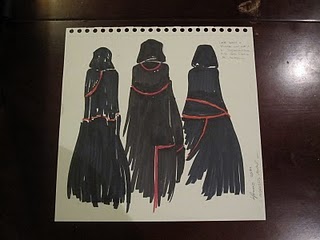
Costume designs for Divina.com
 Pictures from the Exhibition
Pictures from the Exhibition
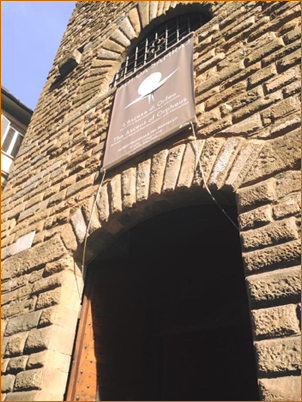
The Ascent of Orpheus Exhibition
(click picture for enlargement)
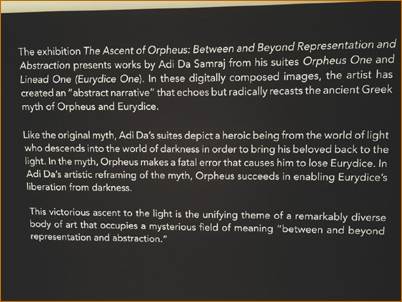
The Ascent of Orpheus Exhibition
(click picture for enlargement)
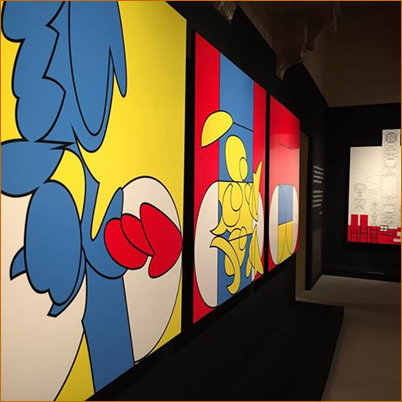
The Ascent of Orpheus Exhibition
(click picture for enlargement)
|

